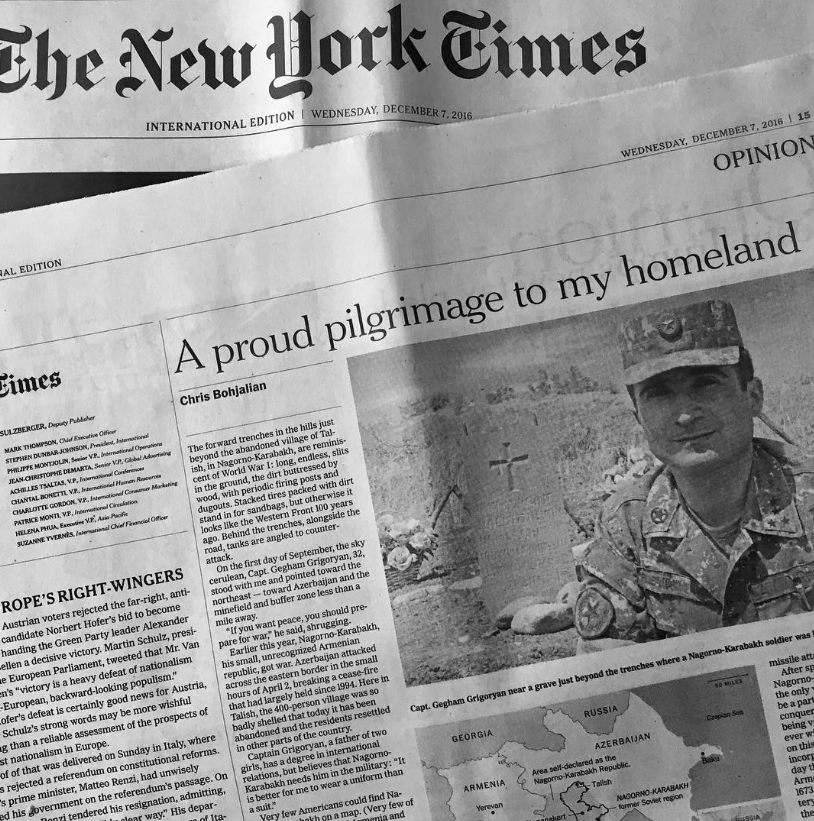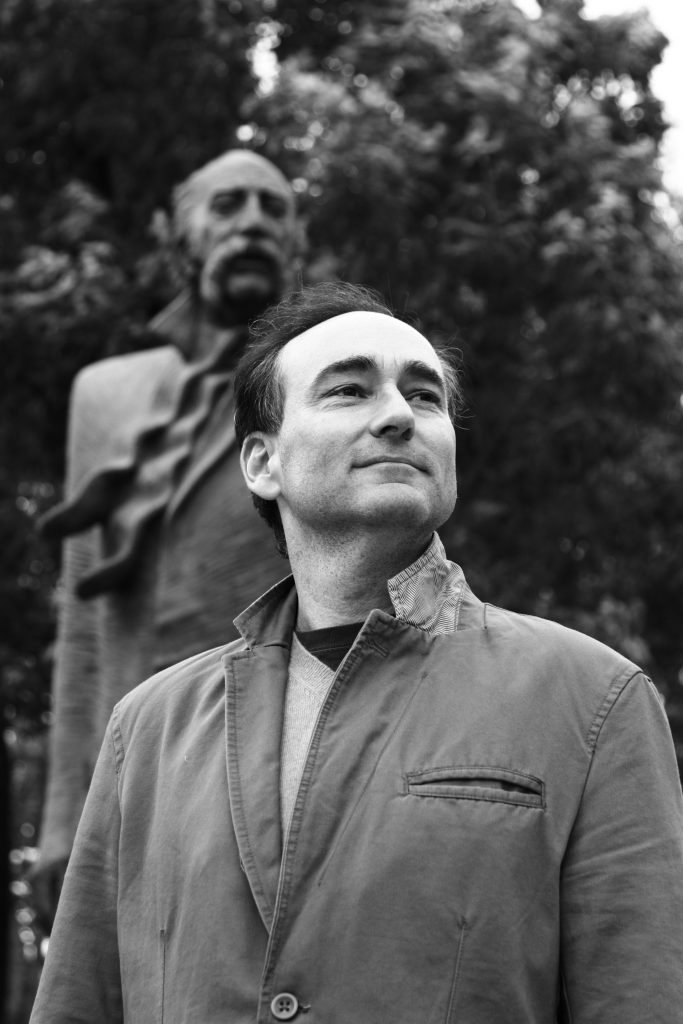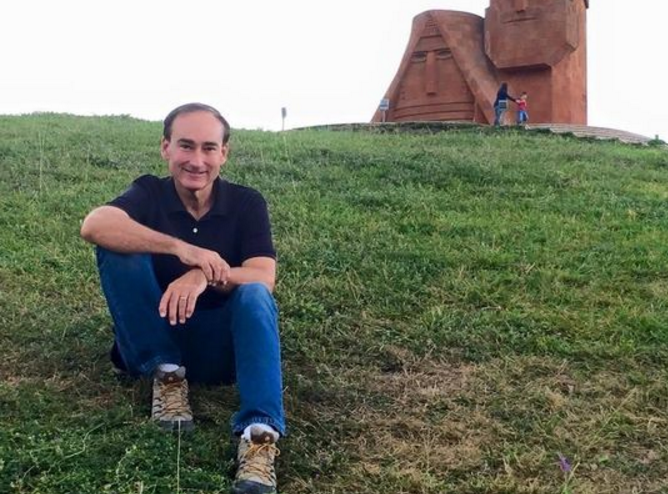An Interview with Chris Bohjalian
Special for the Armenian Weekly
WATERTOWN, Mass. (A.W.)—New York Times Bestselling author Chris Bohjalian’s latest novel, The Sleepwalker—which has already won the praise of several publications—was released earlier today. The Armenian Weekly recently sat down with Bohjalian to discuss the recent release, his writing process, and his first trip to Artsakh (NKR/Nagorno Karabagh).
Bohjalian’s newest offering is a mystery that deals with grief, mourning, and loss. According to him, the novel is also about the notion of secrets. “[W]e all seem to have secrets: husbands and wives, parents and children, lovers. I think The Sleepwalker is about all those secrets that exist behind the closed doors of every home, when the shades are drawn and the doors are locked,” Bohjalian said in his latest interview with the Armenian Weekly.
If it seems as though Bohjalian is one of the hardest working novelists in the world, that is probably because it’s true. “A lot of what I do is about discipline,” he said, when asked about his craft.
Disciplined he is.
Since 2011, for example, he has taken just one year off, publishing a book every year except for 2015.
Bohjalian has published a total of 19 books, including the New York Times bestsellers The Sandcastle Girls, Skeletons at the Feast, The Double Bind, Midwives, and last year’s The Guest Room, which told the captivating story of a 19-year-old from Armenia who is abducted as a teenager, held captive as a sex slave in Russia, and brought to New York City to be exploited.
In 2016, Bohjalian visited Nagorno-Karabagh for the very first time—a place he calls Armenians’ “line in the sand.” There, he was deeply moved by the commitment and resilience of the people. “We will not lose [Artsakh] the way we lost Western Armenia. We will not lose that little country the way we lost Van, Anatolia, Cilicia,” Bohjalian explained.
Currently on a book tour that will cover 19 cities—and, according to him, 4 time zones—Bohjalian seems to be as happy as ever to meet his readers face-to-face. “I am so blessed to have these readers who want to come and listen to me babble, so I’m always very happy to see them. I wouldn’t change it for the world,” he said.
The Sleepwalker can be purchased on Amazon or wherever books are sold.
Below is the interview with Bohjalian in its entirety.
***
Rupen Janbazian: Another year, another novel. We discussed your last book in an interview only a year ago. How do you pull it off?
Chris Bohjalian: A lot of what I do is about discipline. When you graduate from college, a publisher doesn’t say to you, “You look like a young writer of promise. Here’s a boatload of money, go write a book.” So you get a job. And I worked at advertising agencies in Vermont—full-time—until my early thirties. I would write from five in the morning until seven—every day—Saturday mornings, Sunday afternoons, and then Monday and Tuesday nights when I came home from work. I wrote my first three novels while I was employed full-time, and that discipline has served me well. I still begin my day by six in the morning.
R.J.: Walk us through a typical day of writing.
C.B.: The goal is to write 1,000 words a day. I don’t always write 1,000 words, and when I do, a lot winds up on the cutting room floor. But as [American author] Jodi Picoult once observed, it’s much easier to edit a bad page than no page. That’s an important part of the process.
Another thing I think is critical in this digital age is that I try to stay off the social networks in the morning—I try not to answer e-mails in the morning either. Now, you might see some posts from me on the social networks in the morning, but there’s a good chance that I had scheduled them the night before. This is so that I can really remain focused on my characters and the stories that I’m writing.
Finally, I really do try staying at my desk from six in the morning until lunch. As Hemmingway once said, writing is 1 percent inspiration and 99 percent “butt-in-the chair.” That’s a paraphrase, but there’s a certain validity to it.
R.J.: How has your relationship been with your latest characters in The Sleepwalker?
C.B.: My daughter Grace has said about my work that my sweet-spot as a novelist is a seriously messed-up young women. She’s right. That’s true in both my contemporary literature and historical fiction.
To think of the scars of Serafina in The Light in the Ruins, or Emily Shepard in Close Your Eyes, Hold Hands, or Alexandra in The Guest Room, and of course Karine, Nevart, and Hatoun in The Sandcastle Girls—these are women who are strong and courageous, and who have been deeply scarred—sometimes literally—in their lives.
Hatoun is a mute; she can talk, but remains a mute throughout The Sandcastle Girls. Serafina is burning herself in The Light in the Ruins. Emily Shepard is popping OxyContins like M&Ms in Close Your Eyes, Hold Hands.
And in The Sleepwalker, you meet two more of those young women. Lianna, who narrates the book, and her younger sister Paige, who are both scarred by the August night in the year 2000 when their mother sleepwalks into oblivion.
[youtube https://www.youtube.com/watch?v=uCHfbzzAkMk]
R.J.: Why did you decide to set the mother’s disappearance in the year 2000?
C.B.: I set it in the year 2000 for two reasons. First of all, because I wanted a story that wasn’t driven by smartphones. In this day and age, so many mysteries revolve around technology. I didn’t want to write a book about technology.
Secondly, I love something about the first-person past-tense. Books such as [Harper Lee’s] To Kill a Mockingbird, for example—a narrator, who is an adult, looking back on a life-changing moment as a child. There’s a certain amount of wistfulness and foreboding in that construction. The Sleepwalker is set in the year 2000, but Lianna is recounting the story in the year 2017.
R.J.: What about the subject? Sleepwalking.
C.B.: Originally, I thought I was going to write a book about dreams—that great Freudian abyss. And so I was having lunch with the director of the UVM [University of Vermont Medical Center] Sleep Center in Burlington, Vermont. I wanted to understand the physiology of dreams and uncover what it is that the brain is doing when we’re dreaming. He mentioned a patient who was a sleepwalker. And so, rather naturally, the conversation progressed and turned into one about sleepwalking. Soon he was telling me stories about the astonishing thing people do when they sleepwalk.
Virtually anything you can do when you are awake, you can do when you are sleepwalking. Imagine that the part of your brain that controls motor activities is wide-awake and the part that controls judgement and memory is sound asleep. People sleep-cook, sleep-drive, sleep-jog, sleep-sex, sleep-murder, sleepwalk.
It’s also surprisingly common. Ten percent of children sleepwalk at some point. Four percent of adults have at least one sleepwalking experience in the last year.
R.J.: Did you know of these facts or statistics before that meeting and your research?
C.B.: No, I knew virtually nothing about sleepwalking when I started this book. It hadn’t even crossed my mind that there was a novel waiting to be told about sleepwalking.
R.J.: So then what sort of research went into this novel?
C.B.: I loved researching this book. It had two elements of research. First of all, I had a great time learning about sleepwalking—everything about what the brain is doing while you’re sleepwalking to the reality that it’s such a new field. The term “arousal disorder” wasn’t even coined until 1968. Forensic Sleep Medicine or the investigation of sleep crimes weren’t even a discipline until 2007.
I also loved researching how an investigation into a missing person proceeds. That was fascinating to me—chatting with detectives, police, and people who are involved in search-and-rescue, and learning about what you would do if one night, a Vermont mother-of-two just sleepwalked into oblivion.
R.J.: Sleepwalking is the focus, but there must be a multitude of other issues that the novel tackles. I’m thinking back to The Guest Room—the novel’s backdrop was a horrifying account of human trafficking, but the book also dealt with issues such as blackmail, deceit, and marital problems.
C.B.: The book deals with grief, mourning, and what it is like when someone is gone but not dead. The other thing I think The Sleepwalker is about is the notion of secrets—we all seem to have secrets: husbands and wives, parents and children, lovers. I think The Sleepwalker is about all those secrets that exist behind the closed doors of every home, when the shades are drawn and the doors are locked.
R.J.: Let’s go back to your forte—the “seriously messed-up” young women.
C.B.: I would add that they might be messed up, but very courageous.
R.J.: Yes, also courageous. Why is it that you keep returning to these sort of characters? Are the two characters in The Sleepwalker connected—in any way—to any of your previous characters?
C.B.: I think that in some ways, Lianna is a literary descendent of Connie Danforth in Midwives, and her sister Paige is a literary descendent of, perhaps, Laurel Estabrook in The Double Bind. I just mention that in terms of their attitudes and how they speak and their views on life.
I think I’m drawn to these kinds of characters because I am a father of a daughter and sometimes I think I write about my worst fears. There’s a part of me that always roots for the underdog. I think of the epigraph I chose for The Guest Room; it’s from [Soviet Russian author, Boris] Pasternak, from Doctor Zhivago, that beautiful quote about regret: “I don’t think I could love you so much if you had nothing to complain of and nothing to regret.”
When my books work, they’re all about dread and regret. I think that’s what draws me to these characters who are both scarred and courageous.
R.J.: You mentioned your role as a father and how you are drawn to these characters as a result. How has your relationship with your daughter progressed over the years—Or, perhaps, over the novels?
C.B.: Grace has become more and more of a partner in my work. She is one of my first readers of my books. I love her insights into my manuscripts. She’s been reading my books since she was in seventh grade, but she’s been reading my manuscripts since 2011 when she read my first draft of The Sandcastle Girls. Her comments were so smart.
She is, of course, an actor, and one of the things she does for work is she reads audiobooks—she’s read all or parts of three of my books now. We’re very close. Victoria—my wife—and Grace—my daughter—the three of us are sort of a perfect union of three.
R.J.: Switching gears, recently, you mentioned that among the things you wrote in 2016 that you were proudest of was an essay for the New York Times about why, at mid-life, it is so important to you to stand with Armenia and Nagorno-Karabagh.
C.B.: One of the best ways—it seems to me—to help our community is as an advocate for the issues that matter to us. And of course one of those issues is Artsakh. I’ve written a lot over the past four-five years about Western Armenia and genocide recognition for very important publications—the Washington Post, the Boston Globe, Newsweek—but I had never written about Artsakh. I had never written about this fledgling democracy of a 150,000 people, standing tall against a thug-dictatorship of whatever the population of Azerbaijan is—ten million?
And so, this year, for the first time, I went to Artsakh and was so deeply moved by the commitment of the people who lived there. The reality is that we all know that in Armenia, we risk a brain-drain; we risk losing some of our best young people to Russia or other parts of the Diaspora because there aren’t opportunities that they want. And while there is some amazing work being done to keep our young people there, beginning with such things as TUMO, Artsakh is different. Everyone who is in Artsakh is there for the long-haul. Everyone I met there is so committed to building that country, to building a democracy. And so when I came back, I wanted to do what I could to educate my readers about this particular part of our culture and our community.

Bohjalian tweeted this photo on Dec. 31 with the caption, ‘Among the things I wrote in 2016 that I am most proud of is the essay for the New York Times about Armenia, Nagorno-Karabagh, and Azerbaijan—and why at mid-life it is so important to me to stand with Armenia and Nagorno-Karabagh.’
I wrote two stories. I wrote one story about a Syrian-Armenian refugee physician who has been embraced by Artsakh and has now moved there with his teenage daughters. It just struck me as so amazing that this little country that has so little is willing to welcome refugees and help them adjust to a new world, while the United States—which is so rich and so prosperous—views “refugee” as a dirty word.
As for the second story, it seemed to me that during the Four-Day War in April 2016 the coverage was not balanced. I felt that for so many publications around the world, it was very much like the [Organization for Security and Cooperation in Europe-OSCE] Minsk Group: it was as if both sides were violating the ceasefire; it was as if both sides were interested in territorial aggrandizement. It was ridiculous to me. Too few people can even find Nagorno-Karabagh, Armenia, or Azerbaijan on a map, so it seemed to me that the Four-Day War was an opportunity to go there, write about it—not write a news story, but to write an op-ed; an essay about why I stand with Nagorno-Karabagh and how it’s not just a cause of my DNA, but because of the moral authority that belongs to the citizens of NKR. As the [Artsakh] ombudsman said, it’s not just an issue of a people’s right to self-determination; it’s a people’s right to self-determination who are otherwise in peril of extermination.
I view Nagorno-Karabagh as our line in the sand. We will not lose that the way we lost Western Armenia. We will not lose that little country the way we lost Van, Anatolia, Cilicia. Azerbaijan has all the oil; we got all the scrub brush and pomegranates. But the people of Nagorno-Karabagh will defend that scrub brush and pomegranates until the end.
R.J.: Did anything in particular surprise you in Artsakh? You mentioned that it was your first trip.
C.B.: What surprised me was the deep and profound commitment of the people who lived there. They’re all in to build that country. There is almost no cynicism in the zeitgeist of Artsakh.
R.J.: You said you wrote about a Syrian-Armenian refugee physician and his experiences in Artsakh. Over the past five years Syria in general and Aleppo in particular has been the focus of both the worldwide Armenian community and the general public. What are your thoughts on the crisis there, especially with the recent return of the Syrian government-control in Aleppo?
C.B.: It seems to me that the world failed Aleppo. It’s utterly heartbreaking what our community endured there. I think that the community that stayed was monumentally resilient. I’m sure some people stayed because they had no way out and because they had no other alternative. But I certainly don’t begrudge any who left Aleppo. It’s unbelievable what that city was like, especially the last three of the past five years. I will also note that our Diaspora community has tried like heck to do what it can to bolster the Aleppo-Armenian community, and I have to give huge props and a huge shout-out to the myriad of Armenian organizations that worked so hard to bring relief to our brothers and sisters in Aleppo.
R.J.: You dedicate The Sleepwalker to a familiar face to our readers, Eric Nazarian, as well as to Andrew Furtsch.
C.B.: My favorite page in every book is my dedication page. For example, in 2014, I was so thrilled to dedicate Close Your Eyes, Hold Hands to [former Armenian Weekly editor] Khatchig Mouradian, and to my editor of many years Jennifer Jackson. This book is dedicated to two of my closest friends in the world—one in Vermont and one in California.
I dedicated the book to Eric because of his remarkable passion, his creative energy, his moral compass, and his commitment to justice—justice as it relates to our community and justice as it related to all people.
R.J.: Which takes me to my next question. When can we expect Nazarian’s film adaptation of The Sandcastle Girls?
C.B.: That would be a question for Eric! It seems to be humming along nicely. Eric plans to be filming this summer and I think it’s a question now of locking down talent. He’s written a monumentally beautiful screenplay—better than the novel, by far—and managed to get it funded and now it’s just about locking down talent.
R.J.: Better than the novel?
C.B.: Oh, it is. It’s a great screenplay.
R.J.: Any ideas for a future novel?
C.B.: The next book I’m writing is about a hot-mess, alcoholic of a flight attendant for a U.S.-based carrier, who picks up the passenger at 2C between Charles de Gaulle and Dubai and wakes the next morning in bed with him in his hotel suite and someone has cut his throat and he’s dead. She puts the “Do Not Disturb” sign on the door and gets on her flight to Charles de Gaulle and back to JFK, but quickly discovers that you can’t ever escape from a body you leave behind. Her lawyer is named Ani Mouradian.
I was once on a panel with [Academy Award-winning screenwriter] Alex Dinelaris and he was really articulate about how it’s so important for Armenian artists to have characters of Armenian descent and to make it so it’s not “genocide all the time.”
Our culture is bigger than that, it’s better than that—it’s all the fact that we transcended that. And so I just wanted to have a great, interesting, smart, charismatic, young lawyer, who just happens to be Armenian-American.
R.J.: Nineteen cities across four time zones sounds tiring. You must really enjoy touring.
C.B.: Anne Lamott once said, “the only thing worse than a book tour is not having a book tour.”
But really, I’m excited. I’ll be visiting some of my favorite Armenian communities—whether it’s in St. Louis or Providence or Pasadena.
I am so blessed to have these readers who want to come and listen to me babble, so I’m always very happy to see them. I wouldn’t change it for the world.
Source: Armenian Weekly
Link: Bohjalian Speaks About His Craft, Artsakh, and His Latest Offering ‘The Sleepwalker’




